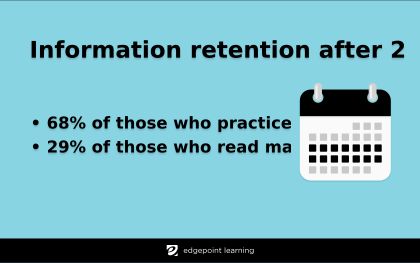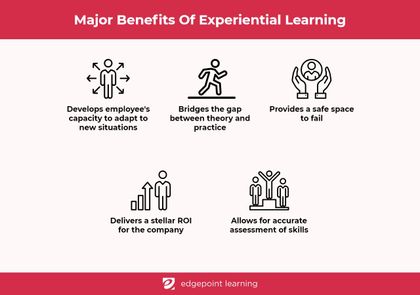5 Benefits Of Experiential Learning In The Workplace
Corey Bleich
🍿 5 min. read
Today’s modern learner is distracted, often untethered to a physical building, and overwhelmed by their responsibilities. Where does this leave time for training and development? Basically, shoehorned into an average of 24 minutes per week. Let’s face it: working smarter, not harder means finding ways to offer valuable training that employees can use (and that sticks for longer than a few minutes). For companies of every size, these five benefits of experiential learning may just point towards the answer.
What is experiential learning in the workplace?
Experiential learning puts your employees at the center of what they need to know (instead of making information the star). Following the Chinese proverb, “I hear and I forget. I see and I remember. I do and I understand,” experiential learning in the workplace is a hands-on type of training that helps employees understand key information by directly performing the task or skill at hand.
Consider these experiential learning examples:
- Call-center employees train by having them role-play calls with their colleagues
- Following a recent emergency situation in an ER, staff uses a simulation to train new employees to see how they might have responded
- A construction company runs through case studies of actual events (e.g., earthquakes or other natural disasters) to better understand different problem-solving options for safer buildings
- Employees are trained at their jobsite using on-the-job mentors (instead of in a classroom)
All of these experiential learning examples focus on learning by doing instead of passive learning models. They can be applied to many different fields and industries, making them an invaluable part of your overall workplace training program.
What's the importance of experiential learning?
Psychologist David Kolb, a pioneer in the field of experiential learning, identifies four components of experiential learning:
- Concrete experience: Active involvement in the experience
- Reflective observations: Analyzing the experience
- Abstract conceptualization: Drawing conclusions and evaluating what students have learned
- Active experimentation: Actually implementing what has been learned
Also known as learning in the flow of work, experiential learning is an opportunity to revolutionize how companies train their employees and develop leaders from within.
It’s no longer enough to just present material once; studies show that offering repeated opportunities for practice of new information and skills vastly improves learning, both in the quantity of what’s learned and the quality of the application.
Experiential learning is coming into its own as expectations of employee training evolve. Consider the following.
- When it comes to practicing what is learned or just studying written material, retention of information past two weeks more than doubles with practice (68% compared to 29%)
- Contrary to popular myth, millennials job-hop less than Generation X, getting all of the training benefits that come with an increased tenure with one employer
- With the growth of AI in the workplace, these same millennials recognize that they need more (and different) training to keep up
- A low supply of highly skilled workers means that experiential learning, on the job, is the new normal when it comes to training your workplace

What are the major benefits of experiential learning in the workplace?
There are five major benefits of experiential learning in the workplace:
- Develops employee's capacity to adapt to new situations
- Bridges the gap between theory and practice
- Provides your team with a safe space to fail
- Delivers a stellar ROI for the company as a whole
- Allows for accurate assessment of skills

Develops capacity to adapt to new situations
In a small-scale study of two groups of students learning about politics, the group of students that learned through internships (experiential learning) and the group that learned through direct instruction had similar success rates on a final exam.
However, when given the task of creating a new legislative policy, those who participated in experiential learning were better able to incorporate all aspects of their learning – the practical, personal, and professional aspects of creating legislation – than those who only learned about legislation in a book.
Employees who learn in the flow of work can become more agile and highly adaptable to new situations.
Bridges the gap between theory and practice
Sure, it’s one thing to read a book about performing open-heart surgery, but it’s quite another to actually do it.
Experiential learning is that sweet spot of practicing the theory you have learned. The very best companies know how to balance their delivery of instruction so that a little time spent with well-designed micro-learning or other instructor-led resources can get the process of practice started in later experiential programs.
Provides a safe space to fail
With employee perception of job security at an all-time low, failure can feel like a doomsday scenario. And yet would you put a pilot with no practice at the helm of a jumbo jet? Probably not.
Experiential learning that uses simulations gives employees the opportunity to fail safely. Their job (and their passengers!) are not in danger when they put their skills to use in simulations and other applicable scenarios (e.g., problem-solving through gamification).
Delivers a stellar ROI
Experiential learning in the workplace provides opportunities for employees to learn while they are in their normal flow of work. This means less time out of the office at a conference or stuck in a boardroom.
While these two training options have their place, for the most part, keeping employees at work while learning provides a better ROI than shipping them off to train somewhere else.
Allows for accurate assessment of skills
Turns out, gathering learning statistics is challenging. Sure, you can analyze whether or not that plane gets landed safely or the cardiac patient survives, but what about seeing how the training works before it gets to that?
Analyzing the data from your experiential learning tools can be very helpful. Simulations and gamification programs can offer tremendous insight into the choices employees make during training. This can, in turn, help employers figure out which skills need more focus and which are rock solid.
Experiential learning, microlearning, gamification, geofencing: it’s a whole new world of training out there. At EdgePoint Learning, we can help you choose and design the employee training that meets your unique needs. Get in touch today.
